Excerpts from Jim Conrad's
Naturalist Newsletter
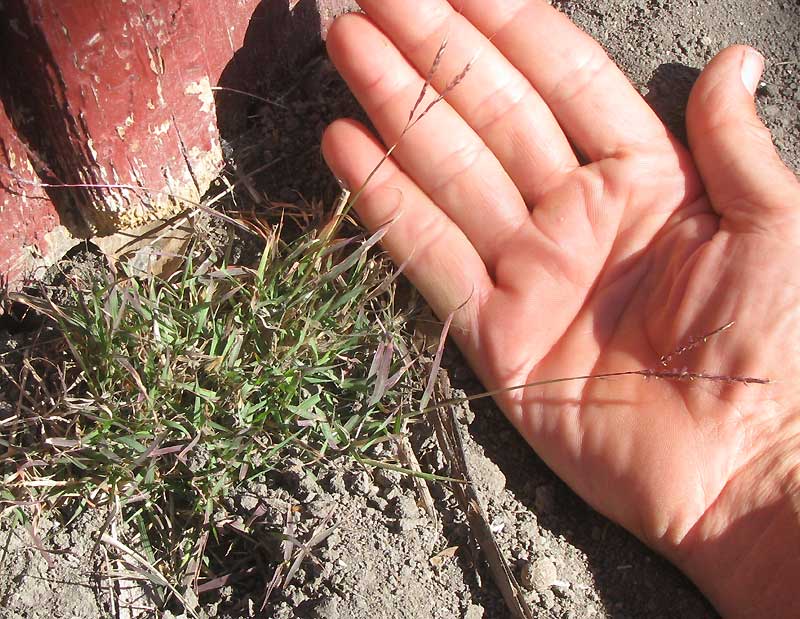
from the January 27, 2013 Newsletter issued from the valley of the Dry Frio River in northern Uvalde County, southwestern Texas, on the southern border of the Edwards Plateau; elevation ~1750m (~5750 ft); N29.62°, W99.86°; USA
KING RANCH BLUESTEM
Though the last week has been warm enough -- the afternoon temperature on Thursday reached 77°F (25°C) -- I've been unable to find a new spring wildflower blossoming. And the two plants featured last week as the first blossomers of spring have disappeared, probably into the guts of deer. However, I did find a grass flowering, a tiny one huddled against the cabin's southwest side where it basks in afternoon sunshine and where it's clearly been nibbled on repeatedly by Minnie the Neighbor's Cow, who both cuts and fertilizes the grassy area around the cabin. You can see what a small, abused looking and homely little grass it is above.
Yet, the grass was indeed flowering and, at least up close, very prettily. Below you can see the tiny, purplish flowers with their stiff bristles, or awns, and with their fuzzy stigmas deployed to catch pollen:
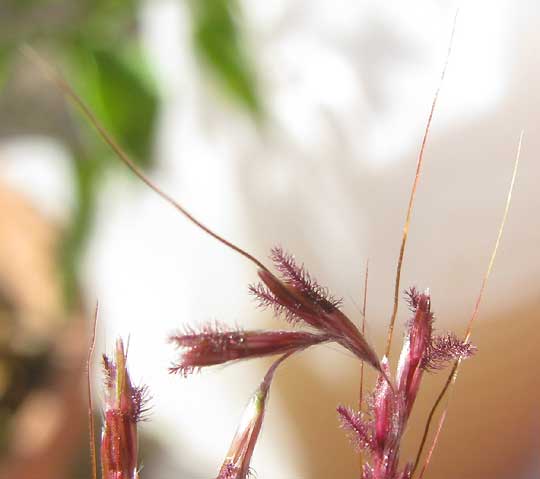
Hungry for spring flowers of any kind I was thankful to this humble little grass for being tough and optimistic enough to blossom in my cow-chomped grassy area here in January. I could hardly wait to identify it, and commit to memory this first flowering grass of the year. A distinctive fieldmark helping during the identification process is the collection of long hairs arising from bulging bases, as shown below:
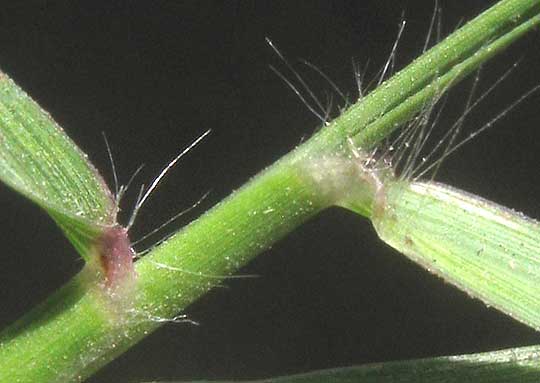
The little grass turned out to be BOTHRIOCHLOA ISCHAEMUM var. SONGARICA, sometimes called Yellow Bluestem but in Texas usually referred to as King Ranch Bluestem. The species is native of central and eastern Asia, from Russia to India, but now occurs nearly worldwide in hot to warmish climates. In its native lands this grass is regarded as excellent for soil and water conservation because of its ease of establishment, rapid growth, grazing tolerance and high forage quality.
For this reason in the late 1800s and early 1900s the species was introduced into the US, and the variety songarica was created on the enormous and historic King Ranch here in Texas. Now the variety has spread beyond the King Ranch and is found widely in the US, mostly in the southern states. Mainly it occurs on soils developed atop limestone, and along roadsides and in weedy fields. And the remarks made about it in Shinners and Mahler's Flora of North Central Texas are typical of opinions about the grass in the US: They say it's "A pernicious weed crowding out native species."
The King Ranch Bluestem page at the TsusInvasives.Org website reports that "... this dominating grass can create monotypic habitats which in turn reduce the diversity of insects, birds and rodents; which can further devastate natural ecosystems. Not only is the grass a threat but so is the insect that utilizes the King Ranch Bluestem as a host plant, the red streaked leafhopper. The red streaked leafhopper has been observed to carry a virus to sugarcane in Thailand, creating crop losses of up to 100% in some areas."
So, the humble little plant singing of spring next to the cabin and filling my heart with gladness with its purple stigmas unfurled into the spring air is a pernicious weed, the bane of insects, birds and rodents, and diversity in general.
Such is the world, illusion piled upon illusion, and the heart hardly knows where to hang its hat.
from the September 22, 2013 Newsletter issued from the Frio Canyon Nature Education Center in the valley of the Dry Frio River in northern Uvalde County, southwestern Texas, on the southern border of the Edwards Plateau; elevation ~1750m (~5750 ft); N29.62°, W99.86°; USA
KING RANCH BLUESTEM IN LATE SUMMER
The plant shown above was less than ankle high, and now I see that it must have been a dwarf state imposed by January's freezing nights. Nowadays King Ranch Bluestems are issuing inflorescences standing knee high and taller, as shown below:

Flowers of those plants, with pinkish stigmas and pale yellow anthers hanging out, are shown below:
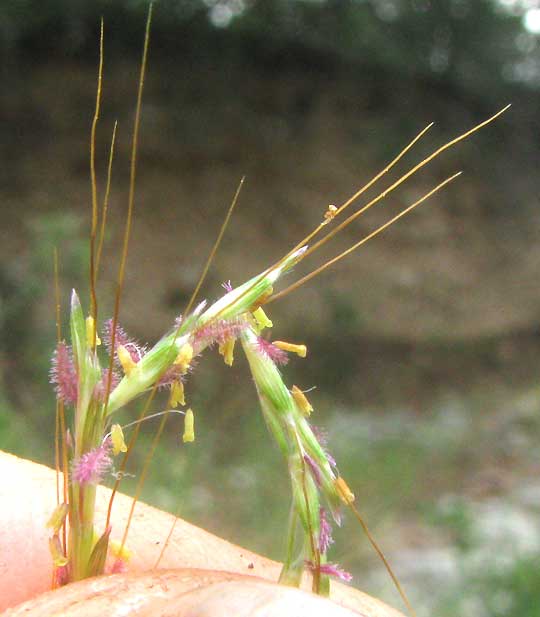
In our January section I quote from a book calling the species "A pernicious weed crowding out native species," and now I can see that in fact it's very common along our roads and out in a large field that started out dominated by native grasses but now, after being bush-hogged for several years, is thick with King Ranch Bluestem.
A 1955 paper by Celarier & Harlan in "Oklahoma Agricultural Experiment Station Technical Bulletin 58" suggests that King Ranch Bluestem is a hybrid between the Old World species Bothriochloa intermedia and Bothriochloa ischaemum.
A 2001 publication called "Pasture and Range Plants," published by Fort Hays State University, in Hays, Kansas, when referring to the hybrid, says, "Our best information indicates this bluestem was introduced to the California Agricultural Experiment Station from Amoy, China in 1917, but was not noticed until 1937 on the King Ranch in Texas. Since this date it has gained much popularity."
Therefore, King Ranch Bluestem wasn't developed on the King Ranch, but the Ranch may have done much to popularize it and spread it throughout our area.
Entry dated January 21, 2024, issued from near Tequisquiapan; bedrock compacted volcanic ash, or tuff; elevation about 1,900m, (6200 ft), ~N20.57°, ~W99.89°; Querétaro state, MÉXICO
KING RANCH BLUESTEM IN MEXICO
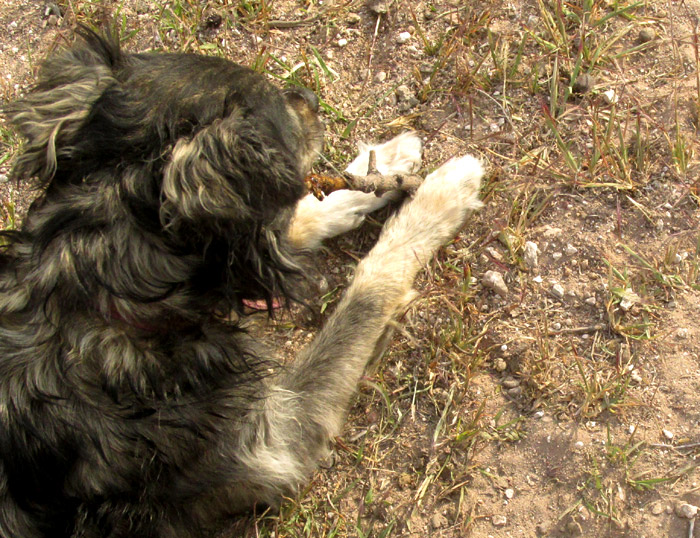
In a large field abandoned because of intense overgrazing and consequent sheet erosion, and during an ongoing intense, two-year-long drought, what vegetation cover remained from unceasing grazing by wandering flocks of sheep was tattered and sparse. Above, Mini the Miniature Schnauzer lies on the field chewing on an acacia stem.
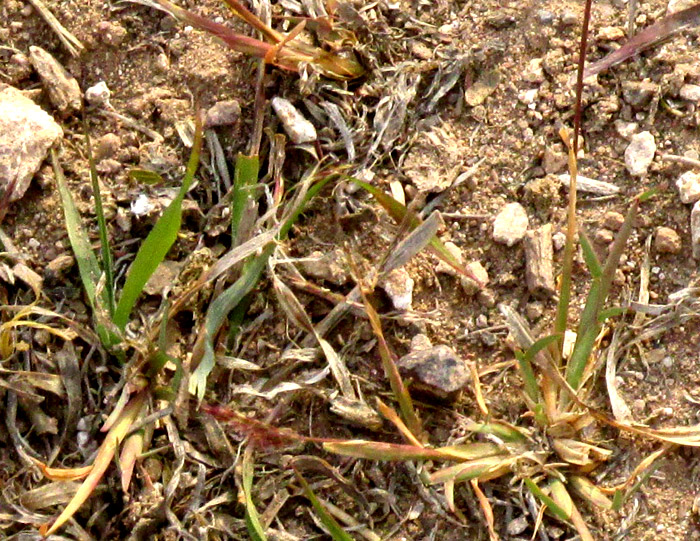
Close-up, it's seen that, at least when frequently cropped, this grass sprouts continually from the base, and sometimes even flowers and fruits before being chomped. Some individuals do die, if only after being trampled by sheep hooves. Below, you see a couple who survived to reproduce:
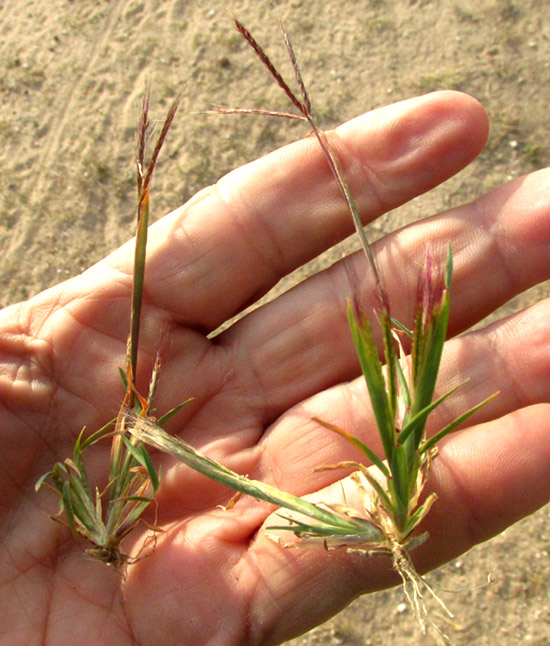
Tough roots originate from a fairly hard stem base, which almost is like a rhizome spouting side shoots and adventitious roots at intervals.
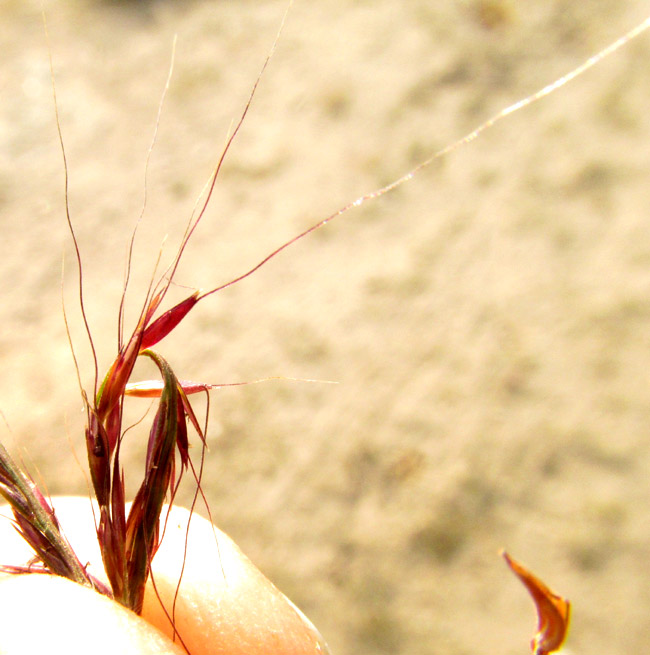
Seeing the above, it was clear that once again we have King Ranch Bluestems with their wintertime dark-red spikelets with long, somewhat twisty bristles arising from their lemmas.
King Ranch Bluestem has been documented all through the US southeastern states as well as most of the drier central states, almost north to Canada. In Mexico, it occurs all the way from southern Texas to about Mexico City just south of here.
Earlier I repeated the observations by others that King Ranch Bluestem is "A pernicious weed crowding out native species." Now I regard this grass as one of the most resilient of Nature's first-aid crew doing its best to stabilize human-abused ecosystems.
Currently Kew's Plants of the World Online, the GIBF database and the online Flora of North America agree that the variety songarica, known as the King Ranch Bluestem, isn't distinct enough from normal regional variations within the general species Bothriochloa ishaemum to warrant taxonomic status. In other words, they say that the variety songarica doesn't exist. Since only that variety is known as King Ranch Bluestem, from a taxonomic perspective, King Ranch Bluestem also doesn't exist. Of course we still can speak of King Ranch Bluestems, because common names have no technical status. In the warmer parts of Eurasia where Bothriochloa ishaemum is native, the variety ishaemum only occasionally is documented; outside the US the species is known in English as Yellow Bluestem.
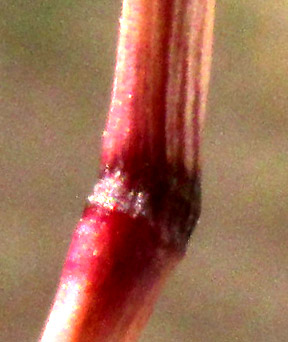
Currently the online Flora of North America says of Bothriochloa ischaemum that "There are two variants that are sometimes recognized as varieties, plants with glabrous nodes being called B. ischaemum var. ischaemum and plants with pubescent nodes being called B. ischaemum var. songarica." The latter variety is King Ranch Bluestem, so our plant should have pubescent, or hairy, stem nodes. At the right, our plants' stem nodes aren't hairy, unless the white zone shows microscopic white hairs. Maybe this fits in with why taxonomists don't afford King Ranch Bluestems official varietal status.